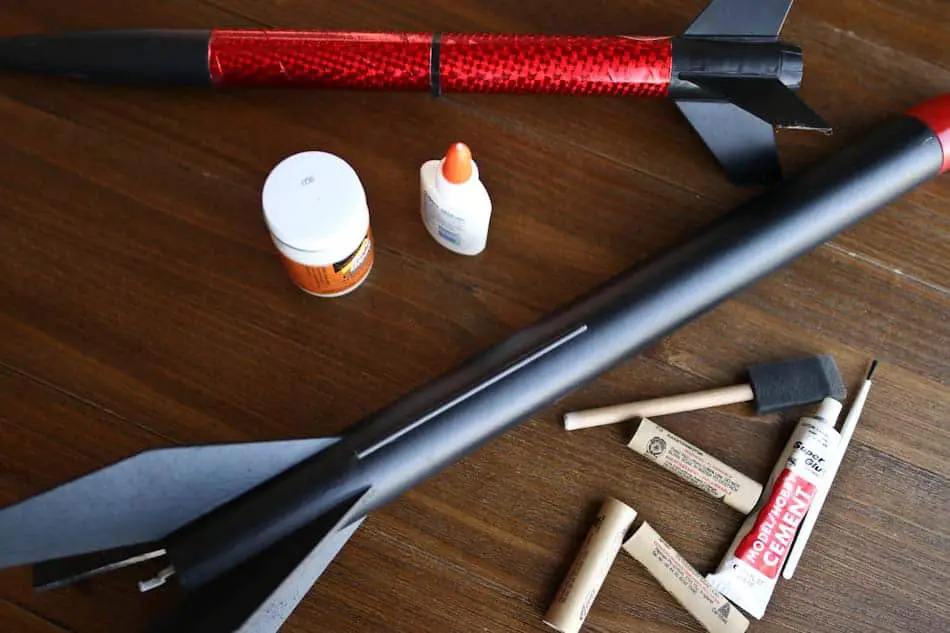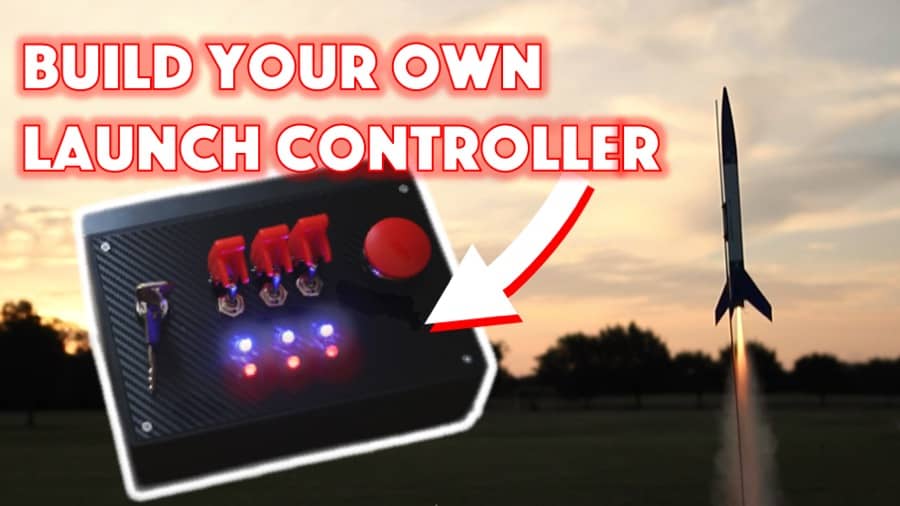
Building a model rocket is a great learning experience, but some might wonder how long it takes. Constructing any type of model requires patience and focus, and this is especially true when it comes to model rockets due to the added nature of aerodynamics and the precision required for flight performance.
So, how long does it take to build a model rocket?
Building a model rocket can take as little as a few minutes for pre-assembled kits, several hours to a few days for kits where you glue and paint the rocket, or months or years if you’re building amateur high-powered rockets.
There is an entire spectrum of model rockets that you can choose to assemble or build, and the time involved really depends on what kind of rocket you are building and where it fits on that spectrum. We’ll lay out low to high levels of assembly and give some examples in each.
Are you still using the standard Estes controllers for your launches?
We just built our own beautiful launch controllers that make launches SO much more fun, and we documented EVERY single step and item purchased and put it into a step-by-step course that teaches you how to do the exact same thing.
Click here to learn more about how you can build your own launch controllers!

Low Level Assembly
A model rocket that is considered low level assembly would take the least amount of time to build, sometimes as little as a few minutes to an hour. These models are designed primarily for beginners and often come with pre-assembled parts for easier construction.
Typically glue and paint are not necessary for these types of kits, which makes them very quick to assemble and launch right away.
For example, the Estes Bandito Flying Model Rocket Kit (link to read reviews on Amazon) is part of a beginner model rocket series. Easy to build, the Bandito rocket is approximately 11 inches in length and has a reported flight altitude of around 600 feet.
Estes estimates that the Bandito model rocket can be assembled in about an hour. Its black, slotted body tube allows for easy installation of the green fins. The matching nose cone is then attached, and the kit comes with yellow and green self-stick decals, so glue and paint are not required for assembly.
If you’re looking for the most basic way to get into model rocketry, these kits that do not require any glue or paint are perfect for you. Particularly if you have young children, this might be a good kit type for them as it very beginner friendly (related reading: Best Model Rockets for 5-9 Year Olds and The Best Model Rockets for Beginners).
Medium Level Assembly
Medium level assembly model rockets take a few hours to build, as they require more assembly than rockets designed for beginning builders but not as much assembly as is required for rockets designed for more experienced builders.
These models are intended for intermediate builders and require more complex skills for construction than pre-assembled kits.
While the total time spent might be a few hours, those hours might have to be spaced over a day or more in order to let glue and paint dry.
Estes’ Der Red Max (link to read reviews on Amazon) is an example of an intermediate model rocket series. The Der Red Max is approximately 16 inches tall with an estimated maximum altitude of 500 feet. The 18-inch parachute is pre-assembled for safe recovery and landing.
The estimated time for assembly of the Der Red Max is between 2 and 4 hours, depending on the skill level and experience of the builder and allowing drying time for paint and glue. This model features laser cut wood fins that will need to be painted, decaled (the kit comes with decals), and glued.
Personally, I always thought these types of kits were really fun because it had enough “DIY” type activities (like glue and paint color of your choice) but not SO many that you get bogged down in a several day build that is easier to mess up.
High Level Assembly
Model rockets that are considered high level assembly would take a much longer time to build. These models are designed for advanced or expert builders and require multiple steps for construction and completion.
The Estes Boosted Bertha (link to read reviews on Amazon) is an example of advanced level model rocketry building. This model is considered a sport rocket with an engine in the main rocket and a booster engine that allows altitudes of 1,000 feet depending on what size engine you use (related reading: Model Rocket Engine Sizes and Classifications).
The Boosted Bertha kit comes with body tubes, laser cut wood fins, a molded plastic nose cone, and decals. Modeling tools and finishing supplies are not included.
The estimated assembly time for this model rocket is at least 4 hours, which does not account for paint or glue drying time. Therefore, it’s best to allow a day or two for start to finish construction of this rocket. Estes recommends builders have advanced building skills, as this rocket kit requires extensive modeling experience.
High Powered and Competitive Rocketry
When it comes to high powered and competitive rocketry, model construction is much more open-ended. Generally, these rockets require a much longer build time than traditional model rockets due to their complexity, precision, and need for iterative testing. It can take months to build a high powered model rocket, and if you’re starting from square one, getting the certifications needed to fly high powered model rockets can take years.
High Powered Rocketry
High powered rocketry is an interesting hobby that requires attention to detail, dedication, and knowledge of aerodynamics, physics, craftsmanship, and more. High powered rocketry is similar to the hobby of model rocketry, though there is a difference in that higher impulse range motors are used. The use of these rocket motors allows performance to exceed traditional model rocket constraints when it comes to weight and propulsion power.
Experienced high powered rocket builders often choose to design and construct their rockets from scratch. This process can take months to up to a year or even longer. For beginners, there are high powered rocket kits that can streamline the process and reduce building time. These kits are designed with expertise and provide clear and detailed directions for construction techniques.
Model Rocket Competition
The National Association of Rocketry (NAR) began model rocket competition in 1959. The organization emphasizes craftmanship, flying skill, and sportsmanship among competitors, and is the only rocket organization in the United States that features a structured program of rocketry competition.
The NAR competition encompasses three primary skill areas:
- Altitude—this is the ability to maximize altitude within a certain power limit. This reflects consistent and reliable model rocket performance that demonstrates high-quality craftsmanship and careful airframe design as well as fin shape to minimize drag.
- Duration—this is the ability to maximize duration with a certain recovery system and retrieval after flight. This reflects recovery system reliability and skill in designing the recovery device for maximum lift. Duration also involves technically terminating flight after a controlled amount of time or retrieving the rocket after flight.
- Craftsmanship—this is the ability to build flying scale models of sounding rockets, missiles, and space launch vehicles with the highest degree of skill. This reflects both the aesthetic of the model as well as its ability to fly.
Competitive rocketry takes skill, perseverance, dedication, and an understanding of various scientific subjects and principles. Competitors can take between a few months to up to a year or longer in building and constructing model rockets for competition.
Benefits of Building a Model Rocket
Because this isn’t just a few minute activity (the build or the launch) regardless of the skill level, it’s important to remember some of the unique benefits of pursuing model rocketry as a hobby for yourself or for your children. There are many benefits that come with building a model rocket.
Doing this activity can help people, especially kids, learn about aerodynamics, chemistry, physics, and other STEM subjects.
STEM is an acronym that stands for the disciplines of science, technology, engineering, and mathematics. STEM subject learning is considered essential when it comes to higher level education and many professional career fields.
Model rocketry fulfills many of the national standards for both mathematics and science, which makes it an excellent addition to K-12 math and science curriculum and programs. Companies such as Estes support model rocket projects in the classroom and offer several packages with bulk materials for schools and teachers in the math and sciences.
The model rocketry process involves and applies the following concepts and more:
- Problem solving
- Prediction
- Reasoning
- Measurement
- Scientific inquiry
- Observation
- Communication
- Controlling variables
- Collecting and interpreting data
- Investigation, hypothesis, and inference
In addition, building a model rocket can be a valuable shared learning experience among students, friends, siblings, and parents with their children to foster cooperation and the reward of task completion. The building process takes time and effort, yet it can inspire people of all ages to pursue rocketry as a hobby, competitive activity, or even a career in aerospace engineering.
Conclusion
Building a model rocket doesn’t have to be intimidating from a time commitment standpoint. Entry level kits require almost no assembly and can be done in under an hour. For those who want to build rockets from scratch, there is a large part of the rocketry community that does just that and can help you with your rocket build that might take weeks, months, or even years. Rocketry can be as simple or as complex as you want to make it, which is one of the many things that makes it so unique. The best way to get started is by a simple kit that doesn’t require much assembly, and you can work your way up from there as you so desire!
Build Your Own Launch Controller
Don’t forget! You can ditch the stock controllers and confidently build your own from scratch using our step-by-step instructions and exact materials list! We promise this will make your launch experience 10x better, and using our course License to Launch you can be 100% confident you’ll be able to finish this project and be super proud of what you’ve built! Here’s a sneak peek below.
